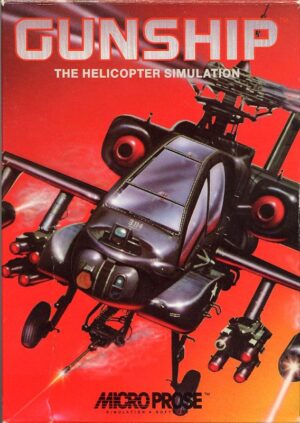Retro Replay Review
Gameplay
Run Baby Run puts you in the driver’s seat of a high-stakes escape, turning the usual cop-versus-thief mechanic on its head by making you the “bad” guy. From the moment the heist is complete, six police cars lock onto your tail in a bid to stop your getaway. Your primary weapon is your vehicle itself: you must deftly maneuver around the city grid, using blocks, barrels, and other environmental obstacles to funnel officers into collisions with one another. Every crash reduces the number of pursuers and brings you one step closer to freedom.
Once you eliminate the initial six cars, a seventh pursuer emerges, armed with a rocket launcher and relentless in its pursuit. This rocket-equipped patrol car patrols the entrance at the bottom-left corner of the screen, guarding your only exit from the map. Its homing rockets add an extra layer of tension, forcing you to balance defensive driving with aggressive tactics. One wrong turn or mistimed block can end your run in a fiery crash.
The game features five distinct levels, each more challenging than the last. As you progress, police cars gain speed, requiring faster reactions and more precise planning. To heighten the stakes, Run Baby Run offers eight different speed settings; selecting a higher speed multiplies your point totals but also drastically reduces your reaction window. This duality of risk versus reward keeps the gameplay loop fresh and encourages repeat attempts to perfect each run.
Graphics
Graphically, Run Baby Run embraces the charm of its vintage arcade roots. The top-down perspective is clean and functional, allowing you to see incoming patrol cars from all sides. While the pixel art may appear simplistic by modern standards, it succeeds in conveying enough detail to differentiate each police unit and environmental hazard at a glance.
The color palette leans heavily on bold primaries—bright reds for your getaway car, stark blues for police vehicles, and vivid yellows for crash animations. These contrasting hues ensure that split-second decisions are made with confidence. Animations are minimal but effective; wrecked cars burst into smoke plumes, alerting you when a blockade has succeeded. The rocket launcher’s projectile is equally clear, giving you time to dodge even in higher-speed modes.
Each level’s backdrop varies subtly, ranging from urban gridlocks to highway-style roadways. Although the aesthetic shifts are not dramatic, they provide just enough visual variety to break the monotony after several runs. Overall, the game’s graphics are functional, purposeful, and faithfully nostalgic, capturing the essence of early arcade racing titles.
Story
Unlike many contemporaries that cast the player as a law enforcement hero, Run Baby Run throws moral convention aside by placing you in the role of the getaway driver. This reversal of perspective infuses the title with an undercurrent of mischievous fun. You’re not chasing justice—you’re desperately fighting to keep your crew’s haul out of police hands.
Though the narrative is minimalistic, it serves its purpose effectively. Each level feels like a fresh escape scenario: one moment you’re weaving through city streets, the next you’re careening down an open stretch guarded by a rocket-wielding cop car. The tension of being “the bad guy” is palpable, especially as you push your luck by setting up perilous traps and high-speed collisions.
The simplicity of the story also leaves room for your own imagination to fill in the blanks. Who are you running for? What was stolen? Every successful escape invites questions, turning a brief arcade session into a momentary dive into a criminal underworld. That sense of implied backstory, conveyed through gameplay rather than cutscenes, adds surprising depth to what could otherwise be a purely mechanical exercise.
Overall Experience
Run Baby Run delivers a fast-paced, arcade-style thrill that remains enjoyable decades after its original release. Its learning curve is welcoming—beginners can clear early levels with a bit of practice—yet the ramp-up in speed and difficulty on higher settings offers a sticky challenge for veteran players. The combination of six initial pursuers and a rocket-armed sentinel car ensures that no two runs feel exactly the same.
Replay value is high due to the multiple speed settings and level layouts. You’ll find yourself chasing higher scores and tighter escape times, experimenting with new blocking strategies and daring maneuvers. The tangible sense of progression as police cars become faster and more ruthless keeps you invested in mastering each scenario.
For fans of retro arcade action or anyone seeking a fresh spin on the driving-simulation genre, Run Baby Run is a compelling choice. Its lean presentation, engaging mechanics, and unique “villain’s perspective” make it stand out among classic titles. While it may not boast the visual polish of modern racers, its core gameplay loop—outwit, outrun, and outlast—remains as addictive as ever, making it a worthy addition to any arcade enthusiast’s collection.
 Retro Replay Retro Replay gaming reviews, news, emulation, geek stuff and more!
Retro Replay Retro Replay gaming reviews, news, emulation, geek stuff and more!









Reviews
There are no reviews yet.